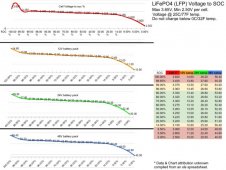toms and Gazoo are both right! Huh?
Toms is right that stopping at .05C is recommended *if you are going to do this on a repetetive basis*, where over the course of say 5 years of charging to absolute full, going to zero tail current adds up in time with secondary reactions. Of course this assumes the use of a charger that is higher that is typically at least 0.2C capable to begin with.
Gazoo is right that a one-time shot just to balance the cells at 3.65v even at a very low < 0.05C initial charge rate, especially in a sub-c application, you won't see any issue. A lab might, but for all practical purposes it's irrelevant. Let it go to zero current even. It's a one time shot.
Putting my propeller hat on, since Gazoo is already starting to balance at less than 0.05c, then technically the CV voltage should be dropped to 3.45v if secondary reactions are a keep you up at night issue.
BUT, as hinted at above with the Winston cells getting an initial higher than normal charge just once to make sure that all the active material has an even charge level spread across it, this function of starting out at 0.05C charge current or less, and instead of stopping at 3.45v, but 3.65v for balancing, replicates this initial one time high charge and may actually be beneficial for a one time shot!
So is there degradation? Not that you can measure on a practical level, unless you plan to charge to full this way every single cycle.
Toms is right that stopping at .05C is recommended *if you are going to do this on a repetetive basis*, where over the course of say 5 years of charging to absolute full, going to zero tail current adds up in time with secondary reactions. Of course this assumes the use of a charger that is higher that is typically at least 0.2C capable to begin with.
Gazoo is right that a one-time shot just to balance the cells at 3.65v even at a very low < 0.05C initial charge rate, especially in a sub-c application, you won't see any issue. A lab might, but for all practical purposes it's irrelevant. Let it go to zero current even. It's a one time shot.
Putting my propeller hat on, since Gazoo is already starting to balance at less than 0.05c, then technically the CV voltage should be dropped to 3.45v if secondary reactions are a keep you up at night issue.
BUT, as hinted at above with the Winston cells getting an initial higher than normal charge just once to make sure that all the active material has an even charge level spread across it, this function of starting out at 0.05C charge current or less, and instead of stopping at 3.45v, but 3.65v for balancing, replicates this initial one time high charge and may actually be beneficial for a one time shot!
So is there degradation? Not that you can measure on a practical level, unless you plan to charge to full this way every single cycle.
Last edited:



